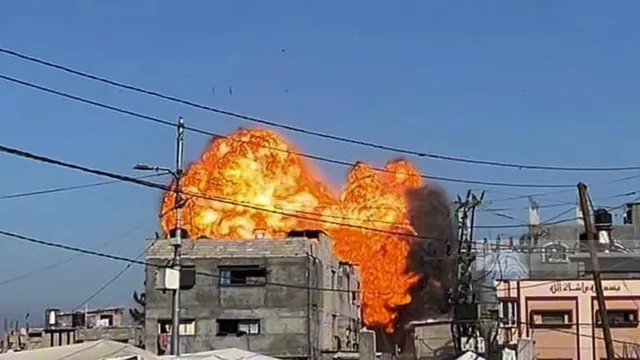
Israeli airstrike eliminates Hamas naval commander in Gaza
2025-07-07 06:00- A recent airstrike in Gaza City targeted and killed Ramzi Ramadan Abd Ali Salah, a prominent leader in Hamas' naval forces.
- The strike reportedly eliminated additional Hamas operatives involved in attacks against Israel, amid escalating violence in the region.
- With Hamas's leadership severely diminished, the group has lost control in Gaza, leading to lawlessness and societal collapse.
Express your sentiment!
Insights
In a recent escalation of military action, the Israeli Defense Forces (IDF) conducted an airstrike in Gaza City that targeted Ramzi Ramadan Abd Ali Salah, the leader of Hamas' naval units. This operation, which occurred last Monday, resulted in Salah's death along with two additional Hamas operatives involved in mortar attacks against Israel. The Israeli military emphasized that the airstrike was carried out with precision-guided munitions and significant intelligence to minimize civilian casualties, though Hamas reported a higher casualty count, claiming 24 fatalities from the strike. The airstrike forms part of a larger conflict between Israel and Hamas, with recent assessments suggesting that Hamas is losing control over Gaza. A senior member of the group indicated that about 95% of Hamas leadership is dead or actively targeted, and the organization's ability to govern effectively has crumbled significantly since the halt of a ceasefire in March. He noted that the security structure within Gaza is virtually non-existent, with rampant looting and total collapse of authority among the citizens. This situation reflects a deteriorating environment within Gaza, as armed gangs and civilians alike have reportedly taken to looting supplies, previously held by Hamas, further indicating the group's diminishing presence and control. This chaos is compounded by the lack of functioning infrastructure, delayed salaries, and a breakdown in communication within the organization. The emerging lawlessness and the perception of a lethal conflict signal a troubling outlook for the people of Gaza, and the ongoing military operations raise questions about the future of stability in the region. As Prime Minister Benjamin Netanyahu travels to Washington D.C. to potentially discuss ceasefire arrangements with President Donald Trump, opinions diverge on the longevity of this conflict. There are those who believe the fighting must continue until an undeniable peace can be reached, while others question the viability of achieving such an outcome given the current state of affairs and ongoing violence. The ramifications of these military strikes and the internal disarray within Hamas will likely affect both the political landscape and humanitarian efforts in the region for the foreseeable future.
Contexts
The Israeli response to Hamas activities has historically been complex and multifaceted, fundamentally driven by the overarching goal of national security and the protection of its citizens. Ongoing hostilities between Israel and Hamas are characterized by a cycle of rocket attacks from Gaza and subsequent airstrikes by the Israeli military. Israel claims that its military operations are a necessary response to prevent missile strikes and other forms of attacks that threaten its population. These responses often result in significant casualties and destruction in Gaza, prompting international criticism about the proportionality of Israel's military actions. The humanitarian ramifications of these confrontations can be severe, impacting not only combatants but also civilians, leading to widespread displacement and a humanitarian crisis in the region. Hamas, designated a terrorist organization by Israel, the United States, and the European Union, justifies its actions through a narrative of resistance against Israeli occupation and perceived oppression. The group has engaged in various forms of attacks, including rocket barrages and tunnel warfare, which have repeatedly escalated tensions. In light of such actions, Israel has employed a range of defensive measures, including the establishment of the Iron Dome missile defense system, which has been effective in intercepting incoming projectiles. This advancement in defensive technology reflects Israel's strategic imperative to minimize civilian casualties while maintaining operational readiness against evolving threats from Hamas. Diplomatic efforts to resolve the conflict have often been intermittent and fraught with challenges. Various international actors, including Egypt and Qatar, have played mediating roles, attempting to broker ceasefires or longer-lasting agreements. Despite initiatives for peace talks, fundamental disagreements over key issues, including borders, sovereignty, and the status of Jerusalem, persist, making sustainable resolution difficult. The Israeli government has at times expressed willingness to negotiate with more moderate Palestinian factions, viewing such dialogues as critical to undermining Hamas' influence, yet the complex political landscape and mutual distrust hinder these efforts. In recent years, the conflict has also drawn increased international scrutiny, with calls for sanctions or other measures to mitigate violence and protect civilians. Responses to Hamas activities have prompted debates over the legality and morality of military actions, including the impact of blockades and restrictions on Gaza. As of July 2025, the situation remains tense, with ongoing military preparedness on both sides. The cyclical nature of violence indicates that any long-term solution will require addressing the underlying conflict dynamics, including political, social, and economic factors that fuel grievances among Palestinians and Israelis alike.